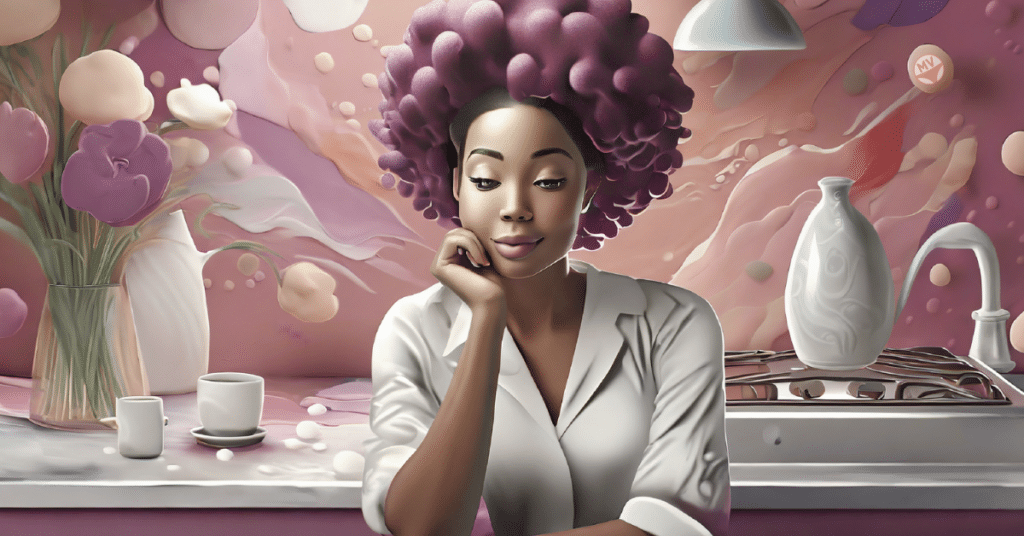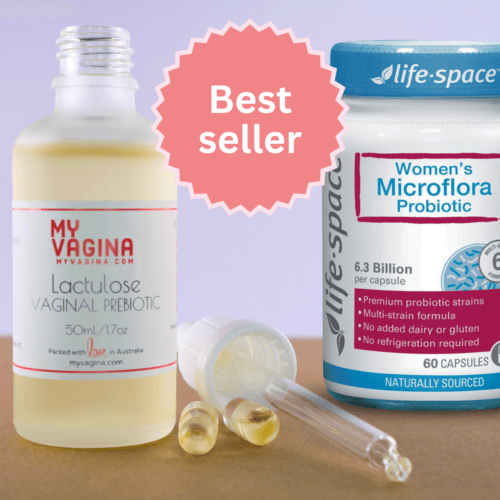Hello Aunt Vadge,
I have been struggling with recurrent BV since the birth of my daughter 1 year ago.
The symptoms I typically develop are yellow/green discharge (and lots of it, usually when I relax my pelvic floor to use the bathroom) and occasional itchiness. I am currently breastfeeding but my cycle returned 4 months postpartum, so I imagine there is a lot of hormone fluctuation going on.
I use boric acid to offset major symptoms and have been taking an oral probiotic for a month now.
I did a vaginal swab a month ago and the results came back positive for Gardnerella Vaginalis and Group B Strep (I was GBS negative during pregnancy though).
With that information, I chose not to take the antibiotic assuming there is a biofilm present.
Instead, I diluted my oral probiotic in water and inserted some vaginally for a few days. This helped tremendously, but after having sex a few times I am back to the same discomfort.
Is this something I can continue doing? Is there a stronger vaginal probiotic suppository you would recommend? I am desperate for long-term relief!
Sincerely,
Suffering
Age 24, Texas USA
__________________________
Dear Suffering,
Sorry to hear that you’re dealing with recurrent BV – it’s such an annoying issue to wrestle with, especially with a new baby and the hormonal merry-go-round of postpartum life.
First things first, it’s okay to be GBS positive now even though you were negative during pregnancy, but it’s important to work out if Group B Strep is contributing to your current symptoms.
The green/yellow discharge suggests it is, which may indicate more of an aerobic vaginitis (AV) influence, rather than a bacterial vaginosis problem.
The difference here is in which microbes are causing all the fuss, which helps us in terms of which to prioritise to get your vagina back on track.
In your case, we don’t have a comprehensive vaginal microbiome panel (which you don’t need a doctor to order BTW). We’ll use the G. vaginalis and GBS as indicators of what’s going on, plus the breastfeeding, which is an important clue to the why of all this.
Here you can find my treatment recommendation, but first I’ll explain a little.
Hormone levels during pregnancy
So, you’re right; fluctuating hormones can certainly contribute to the ups and downs of vaginal health, particularly during breastfeeding, when oestrogen levels can be low due to high prolactin levels.
Oestrogen stimulates a sugar, glycogen, in your vaginal cells, which is the food source for your protective lactobacilli species. Without this energy source, lactobacilli numbers dwindle, and protection gets low, allowing any ole microbe in for a hang. Hello G. vaginalis and GBS!
Learning more about the impact of breastfeeding on estrogen levels
In this post, vulvovaginal specialist naturopath Jessica Lloyd discusses the impact of breastfeeding on estrogen levels, and the vaginal microbiome. The post also has a list of foods that contain phyto-oestrogens, which you can use to increase your systemic oestrogen levels while breastfeeding.
That way, you can work on using food as medicine, rather than relying solely on vaginal treatments, by incorporating some of these foods into your diet on the regular. The problem of low oestrogen isn’t going to go away until you stop nursing.
BV biofilms
Now, about that biofilm assumption – you’re onto something there. Gardnerella vaginalis can be a sneaky little bugger that forms biofilms, which can make treatment more challenging.
Using boric acid can indeed help alleviate symptoms since it has antiseptic properties. The thing with boric acid is to use it wisely and with a clear understanding of when and how often to use it, but realising it is not a cure – it is very useful but most of the time only seems to work as a management tool.
Vaginal and oral probiotics
As for vaginal probiotics, you’ve taken the initiative to introduce some protective bacteria into the environment. However, creating your own vaginal probiotics by mixing formulations with water may be an issue because plain tap water contains chlorine – designed to kill bacteria!
Good idea, but make sure to use unchlorinated water if you opt for this in future.
Look for probiotics that contain vagina-specific Lactobacillus strains, which are typically the dominant protective bacteria in the vagina. Probiotics are considered beneficial and are not harmful1,2.
For odour, discharge, BV, 'mystery bad vag' and to restore a protective vaginal microbiome with specialised vaginal prebiotic and probiotic.
Promote and support a protective vaginal microbiome with tailored probiotic species.
Specially formulated probiotic for vaginal application to promote a healthy vaginal microbiome.
And about that sex connection – it’s quite common for sex to throw off the vaginal flora. Using condoms, urinating after sex, and ensuring both partners have good hygiene can help reduce the impact on your vaginal environment. This is especially true when you have low oestrogen, such as when nursing.
__________________
Treatment recommendation
Visit the post below for isntructions on how to best treat yourself during nursing.
__________________
This combination of treatments will help strengthen and support your vaginal cells so they are producing glycogen again, while specifically targeting the G. vaginalis and GBS, and providing food for your healthy lactobacilli to thrive once again.
As for continuing the approach you’ve been taking, if what I’ve suggested doesn’t offer the results you’re after, it might be worth discussing your situation with one of My Vagina’s incredible holistic naturopaths – they work with vaginas all day every day and can help you.
Lastly, don’t give up hope for long-term relief! Keep advocating for your health, consider a chat with a healthcare professional about your concerns and treatment options, and keep taking care of yourself, both down there and overall.
Sending you lots of strength and hoping you find that relief very soon! Keep your chin up, you’re doing the best you can.💕
Lots of love,
Aunt Vadge
References
- 1.Sheyholislami H, Connor KL. Are Probiotics and Prebiotics Safe for Use during Pregnancy and Lactation? A Systematic Review and Meta-Analysis. Nutrients. Published online July 13, 2021:2382. doi:10.3390/nu13072382
- 2.Gomez Arango LF, Barrett HL, Callaway LK, Nitert MD. Probiotics and Pregnancy. Curr Diab Rep. Published online November 11, 2014. doi:10.1007/s11892-014-0567-0
Get a fresh perspective with a qualified, experienced vulvovaginal specialist naturopath.
This product has multiple variants. The options may be chosen on the product pageThe most comprehensive vaginal microbiome test you can take at home, brought to you by world-leading vaginal microbiome scientists at Juno Bio.
Easy-to-use BV and AV treatment program.
Promote and support a protective vaginal microbiome with tailored probiotic species.








